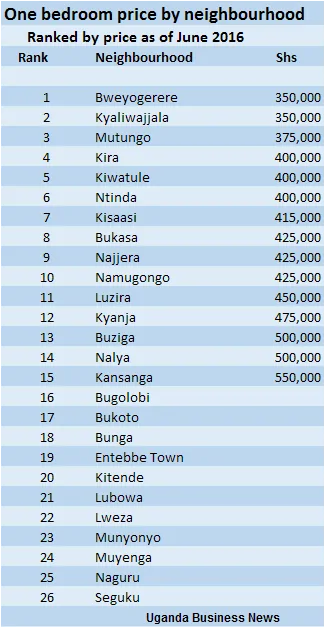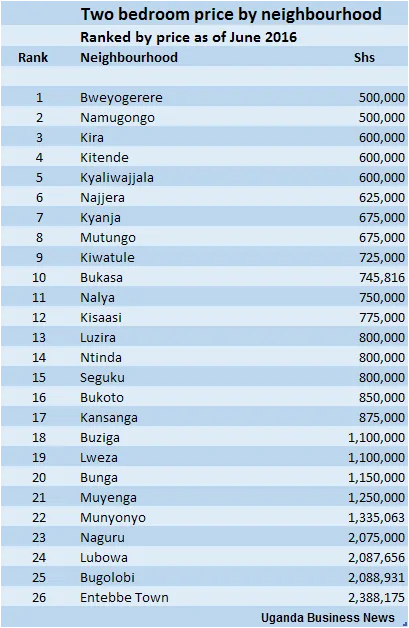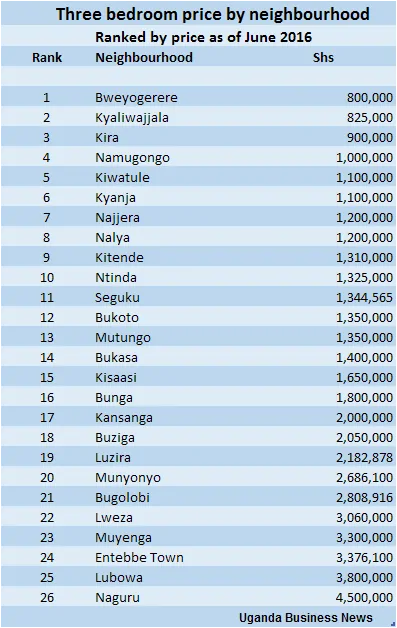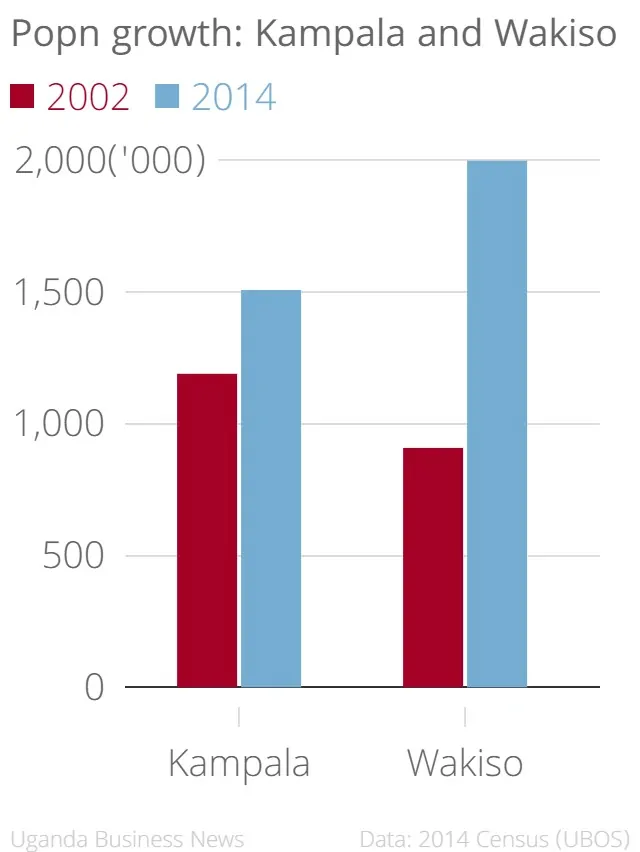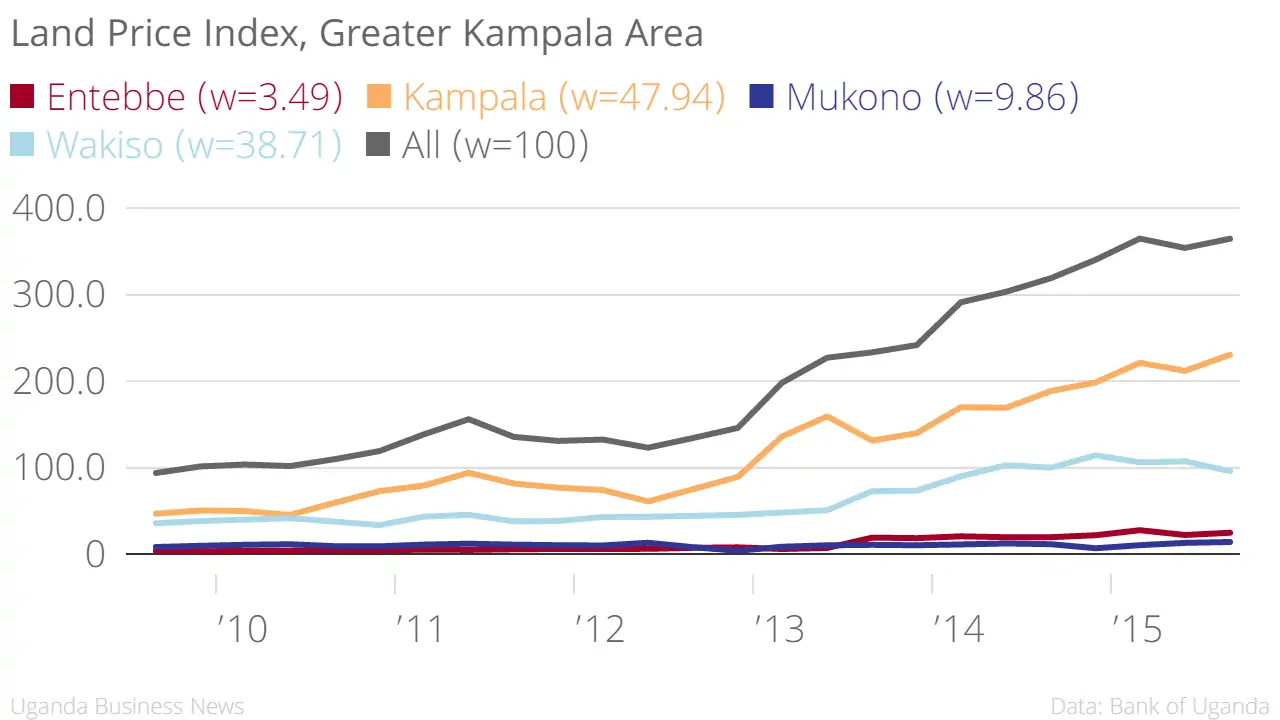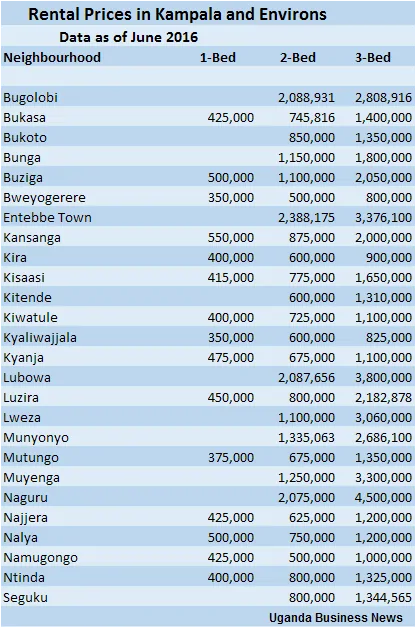You could choose to pay one month’s rent in Naguru. Or pack your bags to Kiwatule and lock down a three bedroom for four months.
Uganda Business scoured listings on OLX Uganda, Facebook, and real estate websites posted over the last six months for rentals in various Kampala and Wakiso suburbs. The rates are median rental prices for one, two, and three unfurnished bedroom units.
Kyaliwajjala and Bweyogerere are the most affordable locations. A one bedroom will cost 350,000 in both locations, a two bedroom will set you back 500,000 in Bweyogerere and 600,000 in Kyaliwajjala, while a three bedroom is 800,000 in Bweyogerere and 825,000 in Kyaliwajjala.
But what if you fancied living in the more upscale suburbs around the city? What you pay for a three bedroom in Bweyogerere is not enough to get you a two bedroom in Munyonyo, which goes for 1,335,063.
And Munyonyo is pretty mid-range compared to serene Lubowa or colonial Entebbe, where a two bedroom exceeds two million.
We used median rates, which are the standard in the real estate sector, because they give a more realistic value. The median is less affected by extremes as it gives a figure midway between the lowest and highest rates, unlike an average rate which is influenced by extremes.
This does not mean that it is free of errors. In some popular and oversubscribed areas, for example, only the really expensive units might have been on the market when the data was collected. This would give the impression that they are more expensive than they really are.
Indeed, the most recent information about demand for rental units in expensive suburbs shows it was subdued. This was in the last two quarters of 2015, according to Knight Frank Uganda’s ‘Kampala Market Update’ for the period.
It’s also difficult finding a one-bedroom unit in the more exclusive neighbourhoods. There are two possible explanations for this. One is that they are taken right as soon as they become available. That is if any are built in the first place: those who can afford to buy and build in Muyenga or Lubowa have very little limitations on the size of property they can put up. And it is not like they are targeting or thinking of the type of client who can afford a one-bedroom unit.
Instead, such units are common in up-and-coming neighbourhoods. These include – but are not limited to – Kira, Bweyogerere, Namugongo, Najjera, and Kyanja. Most listings on OLX are of properties in those areas, meaning its where most new construction is taking place.
Over the last two decades, these areas, all of which – with the exception of Kyanja – are located in Wakiso District, have been attracting land buyers and renters priced out of suburbs in the city. This trend has mirrored the district’s growth in population: 2014 census figures rank it as the most populated district in Uganda, followed by Kampala. In 2002 Kampala was the most populated district, and Wakiso second.
Kira and Najjera (and Nalya) were also singled out for mention by Knight Frank in its Uganda Market Update for the first half of 2016, as properties in those suburbs were responsible for most of the new residential units the firm listed for sale in the period. The suburbs are “becoming increasingly popular for middle income home owners,” according to the update.
Although only 21% of all households in the country live in rented houses, 50% of urban households rent their homes (compared to 12.3% in rural areas), according to census figures. This figure has most certainly gone up from 2002, when 15% of all households lived in rented premises. In Kampala 69% of all households rent, according to the Kampala Physical Development Plan (2012).
Still, the plan noted that there is a shortage of appropriate housing that will take some time to address. The greater Kampala metropolitan area needs between 700,000 to 800,000 new housing units by 2021 to meet projected population growth and housing demand, according to the plan. Of those, 400,000 have to be of ‘reasonable to high standard’ while 300,000 have to meet basic standards.
This demand presents opportunities for those looking to invest in the sector. For those who might not be able to pay the prices asked for land in Kampala, neighbouring Wakiso is a good buy. Between September 2014 and September 2015, the unit cost of land fell by 4% in Wakiso (excluding Entebbe), compared to an increase of 22.22% in Kampala.
But if you are not yet ready to buy land and build your own house, you don’t have that many options other than renting. Which means you will find this cheat sheet handy (all prices are in Uganda shillings).
